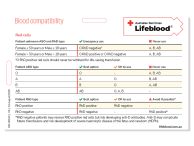Don’t have an account?
Select the donation type you’d like to make
Many blood group systems have been identified, but for transfusion safety the two most important blood group systems are ABO and Rh.
Correctly identifying the blood groups of both blood donors and recipients is vital for ensuring that suitably compatible products are selected for transfusion.
The clinical importance of the various blood groups depends on their ability to stimulate antibodies that can destroy transfused red blood cells or cross the placenta and cause haemolytic disease of the fetus and newborn (HDFN).
This is dependent upon:
- the frequency with which antigens and antibodies occur, which may vary in different populations due to ethnic diversity
- the functional characteristics of antibodies such as thermal range, immunoglobulin class, titre, avidity and ability to fix complement
Updated April 2025



